项目代码
https://github.com/yinhai1114/Java_Learning_Code/tree/main/IDEA_Chapter14/src/com/yinhai/collection_
https://github.com/yinhai1114/Java_Learning_Code/tree/main/IDEA_Chapter14/src/com/yinhai/list_
集合
一、集合引入
前面我们保存多个数据使用的是数组,那么数组有不足的地方,我们分析一下。
数组
1)长度开始时必须指定,而且一旦指定,不能更改
2)保存的必须为同类型的元素
3)使用数组进行增加元素的示意代码-比较麻烦
写出Person数组扩容示意代码。
Person[] pers = new Person[1];
per[0]=new Person();Person[] pers2 = new Person[pers.length+ 1]; //新创建数组
for(){} //拷贝pers数组的元素到pers2
pers2[pers2.length-1]=new Person();//添加新的对象
集合
1)可以动态保存任意多个对象,使用比较方便!
2)提供了一系列方便的操作对象的方法: add、remove、set、 get等
3)使用集合添加,删除新元素的示意代码-简洁了
二、集合的框架体系
集合主要分两组 单列和双列
单列集合 两个重要的两个子接口List Set
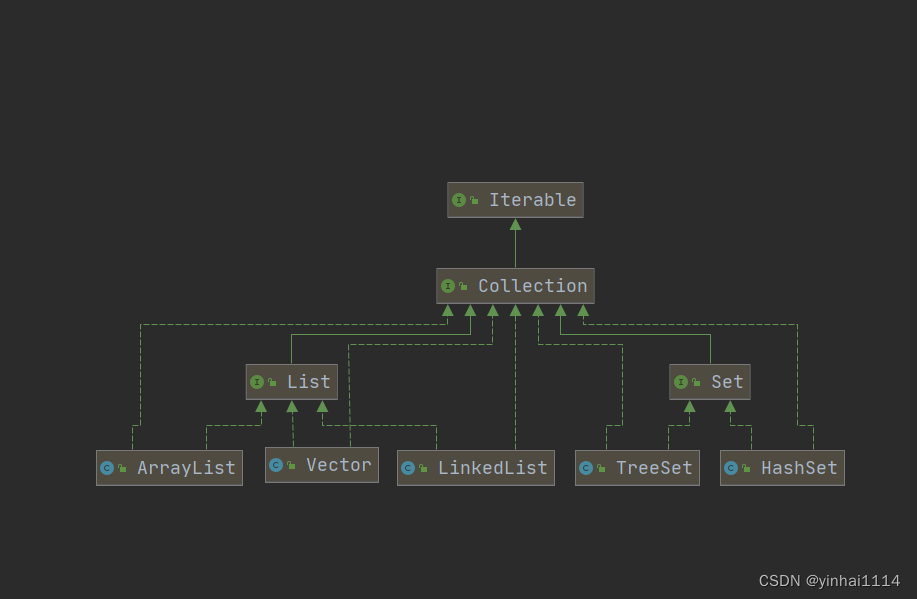
双列集合 属于双列集合,存放K-V的数据
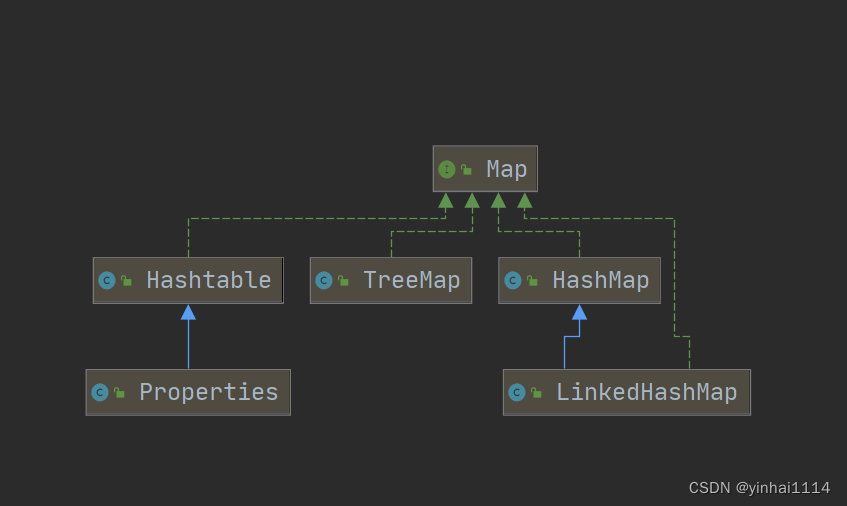

Collection类
一、Collection类接口和常用方法
Collection接口实现类的特点
public interface Collection<E> extends iterable <E>
1) collection实现子类可以存放多个元素, 每个元素可以是bject
2)有些Collection的实现类,可以存放重复的元素,有些不可以
3)有些Collection的实现类,有些是有序的(List),有些不是有序(Set)
4) Collection接口没有直接的实现子类,是通过它的子接口Set和List来实现的
public class CollectionMethod {@SuppressWarnings({"all"})public static void main(String[] args) {List list = new ArrayList();//add:添加单个元素list.add("jack");list.add(10);//list.add(new Integer(10))对象list.add(true);System.out.println("list=" + list);//remove:删除指定元素//list.remove(0);//删除第一个元素list.remove(true);//指定删除某个元素System.out.println("list=" + list);//contains:查找元素是否存在System.out.println(list.contains("jack"));//T//size:获取元素个数System.out.println(list.size());//2//isEmpty:判断是否为空System.out.println(list.isEmpty());//F//clear:清空list.clear();System.out.println("list=" + list);//addAll:添加多个元素ArrayList list2 = new ArrayList();list2.add("红楼梦");list2.add("三国演义");list.addAll(list2);System.out.println("list=" + list);//containsAll:查找多个元素是否都存在System.out.println(list.containsAll(list2));//T//removeAll:删除多个元素list.add("聊斋");list.removeAll(list2);System.out.println("list=" + list);//[聊斋]}
}
二、Iterator迭代器
Collection接口遍历元素方式1-使用Iterator(迭代器)
1.基本介绍
1) Iterator对象称为迭代器,主要用于遍历Collection集合中的元素。
2)所有实现了Collection接的集合类都有个iterator(方法, 用以返回一个实现了Iterator接口的对象,即可以返回一个迭代器。
3) Iterator的结构
4) Iterator仅用于遍历集合,Iterator 本身并不存放对象。
2.迭代器的执行原理
Iterator iterator = coll.iterator(): //得到一个集合的迭代器
//hasNext():判断是否还有下一个元素
while(iterator.hasNext()){
//next(:@下移②将下移以后集合位置上的元素返回
System.out.println(iterator.next());



public class CollectionIterator {@SuppressWarnings({"all"})public static void main(String[] args) {Collection col = new ArrayList();col.add(new Book("三国演义", "罗贯中", 10.1));col.add(new Book("小李飞刀", "古龙", 5.1));col.add(new Book("红楼梦", "曹雪芹", 34.6));System.out.println("col=" + col);//希望遍历该集合//1.先得到col对应的迭代器Iterator iterator = col.iterator();//2.使用while循环遍历while(iterator.hasNext()){//判断是否还有数据//返回下一个元素,类型是ObjectObject obj = iterator.next();System.out.println("obj" + obj);}//快捷键,快速的生成while循环->itit (Ctrl +J 可以显示快捷模版)////3.当退出while循环后,这是iterator迭代器指向最后的元素//iterator.next();//NoSuchElementException//4.再次遍历需要重置我们的迭代器iterator = col.iterator();}
}class Book {private String name;private String author;private double price;public Book(String name, String author, double price) {this.name = name;this.author = author;this.price = price;}public String getName() {return name;}public void setName(String name) {this.name = name;}public String getAuthor() {return author;}public void setAuthor(String author) {this.author = author;}public double getPrice() {return price;}public void setPrice(double price) {this.price = price;}@Overridepublic String toString() {return "Book{" +"name='" + name + '\'' +", author='" + author + '\'' +", price=" + price +'}';}
}
3.增强for循环完成迭代器
增强for循环,可以代替iterator迭代器, 特点:增强for就是简化版的iterator本质样。只能用于遍历合或数组。
基本语法
for(元素类型元素名:集合名或数组名) {访问元素}
public class CollectionFor {@SuppressWarnings({"all"})public static void main(String[] args) {Collection col = new ArrayList();col.add(new Book("三国演义", "罗贯中", 10.1));col.add(new Book("小李飞刀", "古龙", 5.1));col.add(new Book("红楼梦", "曹雪芹", 34.6));for (Object o : col) {System.out.println("book=" + o);}//1. 使用增强for, 在Collection集合//2. 增强for, 底层仍然是迭代器//3. 增强for可以理解成就是简化版本的 迭代器遍历//4. 快捷键方式 I// for (Object book : col) {// System.out.println("book=" + book);// }//增强for,也可以直接在数组使用// int[] nums = {1, 8, 10, 90};// for (int i : nums) {// System.out.println("i=" + i);// }}
}增强for, 底层仍然是迭代器
增强for可以理解成就是简化版本的 迭代器遍历
4.迭代器练习
public class CollectionExercise {@SuppressWarnings({"all"})public static void main(String[] args) {List list = new ArrayList();list.add(new Dog("小黑", 3));list.add(new Dog("大黄", 100));list.add(new Dog("大壮", 8));//先使用for增强for (Object dog : list) {System.out.println("dog=" + dog);}//使用迭代器System.out.println("===使用迭代器来遍历===");Iterator iterator = list.iterator();while (iterator.hasNext()) {Object dog = iterator.next();System.out.println("dog=" + dog);}}
}
/*** 创建 3个 Dog {name, age} 对象,放入到 ArrayList 中,赋给 List 引用* 用迭代器和增强for循环两种方式来遍历* 重写Dog 的toString方法, 输出name和age*/
class Dog {private String name;private int age;public Dog(String name, int age) {this.name = name;this.age = age;}public String getName() {return name;}public void setName(String name) {this.name = name;}public int getAge() {return age;}public void setAge(int age) {this.age = age;}@Overridepublic String toString() {return "Dog{" +"name='" + name + '\'' +", age=" + age +'}';}
}三、List接口方法
1.List接口基本介绍
List接口是Collection接口的子接口
1) List集合类中元素有序(即添加顺序和取出顺序一致)、 且可重复[案例]
2) List集合中的每个元素都有其对应的顺序索引,即支持索引。[案例]
3) List容器中的元素都对应一 个整数型的序号记载其在容器中的位置,可以根据序号存取容器中的元素。
List list = new ArrayList(;
4) JDK API中List接口的实现类有
2.List的常用方法
public class ListMethod {@SuppressWarnings({"all"})public static void main(String[] args) {List list = new ArrayList();list.add("张三丰");list.add("贾宝玉");//void add(int index, Object ele):在index位置插入ele元素//在index = 1的位置插入一个对象list.add(1, "韩顺平");System.out.println("list=" + list);//boolean addAll(int index, Collection eles):从index位置开始将eles中的所有元素添加进来List list2 = new ArrayList();list2.add("jack");list2.add("tom");list.addAll(1, list2);System.out.println("list=" + list);//Object get(int index):获取指定index位置的元素//collection方法有//int indexOf(Object obj):返回obj在集合中首次出现的位置System.out.println(list.indexOf("tom"));//2//int lastIndexOf(Object obj):返回obj在当前集合中末次出现的位置list.add("韩顺平");System.out.println("list=" + list);System.out.println(list.lastIndexOf("韩顺平"));// Object remove(int index):移除指定index位置的元素,并返回此元素list.remove(0);System.out.println("list=" + list);//Object set(int index, Object ele):设置指定index位置的元素为ele , 相当于是替换.list.set(1, "玛丽");//一定要存在才能替换System.out.println("list=" + list);//List subList(int fromIndex, int toIndex):返回从fromIndex到toIndex位置的子集合// 注意返回的子集合 fromIndex <= subList < toIndex [0,2)List returnlist = list.subList(0, 2);System.out.println("returnlist=" + returnlist);}
}
3.List练习

public class ListExercise {public static void main(String[] args) {List list = new ArrayList();for (int i = 0; i < 12; i++) {list.add("hello" + i);}//在索引为1插入一个元素list.add(1,"hspedu");System.out.println("list=" + list);//在abstractCollection内有toString方法//获得下标为4的元素System.out.println("第五个元素" + list.get(4));//删除下标为5的元素list.remove(5);System.out.println("list" + list);//修改第七个元素list.set(6,"三国演义");//使用迭代器for (Object o : list) {System.out.println(o);}Iterator iterator = list.iterator();while (iterator.hasNext()) {Object next = iterator.next();System.out.println(next);}}
}
4.ListFor三种遍历方式与三种子类
List的三种遍历方式while for增强 for普通
[ArrayList, LinkedList,Vector]三种运行类型。只要是实现List接口的子类都能这么遍历。(区别后面会讲)
//List 接口的实现子类 Vector LinkedList
List list = new ArrayList();
List list = new Vector();
List list = new LinkedList();
public class ListFor {@SuppressWarnings({"all"})public static void main(String[] args) {//List 接口的实现子类 Vector LinkedList//List list = new ArrayList();//换成ArrayList代码也不会报错//List list = new Vector();//换成Vector也不会报错List list = new LinkedList();list.add("jack");list.add("tom");list.add("鱼香肉丝");list.add("北京烤鸭子");//遍历//1. 迭代器Iterator iterator = list.iterator();while (iterator.hasNext()) {Object obj = iterator.next();System.out.println(obj);}System.out.println("=====增强for=====");//2. 增强forfor (Object o : list) {System.out.println("o=" + o);}System.out.println("=====普通for====");//3. 使用普通forfor (int i = 0; i < list.size(); i++) {System.out.println("对象=" + list.get(i));}}
}
5.List接口课堂练习

public class ListExercise01 {@SuppressWarnings({"ALL"})public static void main(String[] args) {List list = new ArrayList();list.add(new Book("三国演义", "罗贯中", 10.1));list.add(new Book("小李飞刀", "古龙", 5.1));list.add(new Book("红楼梦", "曹雪芹", 34.6));list.add(new Book("活着", "余华", 12.4));list.add(new Book("3年模拟", "新华", 60.0));//如何对集合进行排序sort(list);for (Object o : list) {//直接sout(list)的话调用的是AbstactCoolection的toShtring方法,虽然也会调用对象的toString,但格式不对System.out.println(o);}}public static void sort(List list){for (int i = 0; i < list.size() - 1; i++) {for (int j = 0; j < list.size() - i - 1; j++) {//取出对象Book book = (Book)list.get(j);Book book1 = (Book)list.get(j + 1);if (book.getPrice() < book1.getPrice()){list.set(j,book1);list.set(j + 1,book);}}}}
}
class Book {private String name;private String author;private double price;public Book(String name, String author, double price) {this.name = name;this.author = author;this.price = price;}public String getName() {return name;}public void setName(String name) {this.name = name;}public String getAuthor() {return author;}public void setAuthor(String author) {this.author = author;}public double getPrice() {return price;}public void setPrice(double price) {this.price = price;}@Overridepublic String toString() {return "名字=" + name + "\t\t作者=" + author + "\t\t价格=" + price;}
}

四、ArrayList 的底层结构和源码分析(建议多看看)
1.ArrayList的细节
1)permits all elements, including null,ArrayList可以加入null,并且多个
2) ArrayList是由数组来实现数据存储的
3) ArrayList基本等同于Vector,除了ArrayList是线程不安全(执行效率高)看源码.,
在多线程情况下,不建议使用ArrayList
public class ArrayListDetail {public static void main(String[] args) {//ArrayList 是线程不安全的, 可以看源码 没有 synchronized/*public boolean add(E e) {ensureCapacityInternal(size + 1); // Increments modCount!!elementData[size++] = e;return true;}*/ArrayList arrayList = new ArrayList();arrayList.add(null);arrayList.add("jack");arrayList.add(null);arrayList.add("hsp");System.out.println(arrayList);}
}2.ArrayList的源码分析(重点难点)
1) ArrayList中维护了一个Object类型的数组elementData.
transient Object[] elementData;//tansient表示瞬间,将来这个被修饰的对象不会被序列化
2)当创建ArrayList对象时,如果使用的是无参构造器,则初始elementData容量为0,第1次添加,则扩容elementData为10, 如需要再次扩容,则扩容elementData为1.5倍。//每次都会检测扩容
3)如果使用的是指定大小的构造器,则初始elementData容量为指定大小,如果需要扩容,则直接扩容elementData为1.5倍。
用下列源码debug看
public class ArrayListSource {public static void main(String[] args) {//注意,注意,注意,Idea 默认情况下,Debug 显示的数据是简化后的,如果希望看到完整的数据//需要做设置.//使用无参构造器创建ArrayList对象ArrayList list = new ArrayList();// ArrayList list = new ArrayList(8);//使用for给list集合添加 1-10数据for (int i = 1; i <= 10; i++) {list.add(i);}//使用for给list集合添加 11-15数据for (int i = 11; i <= 15; i++) {list.add(i);}list.add(100);list.add(200);list.add(null);}
}
源码流程图

在debug的时候会出现数据省略的可以设置

省略null数据可以设置显示

五、Vector类的底层结构和源码分析(建议多看看)
1.Vector的基本介绍
1) Vector类的定义说明
public class Vector<E>
extends AbstractList<E>
implements List<E>, RandomAccess, Cloneable, Serializable
2) Vector底层也是一个对象数组, protected Object[] elementData;
3) Vector是线程同步的,即线程安全,Vector类的操作方法带有synchronized
public synchronized E get(int index) {
if (index > = elementCount)
throw new ArrayIndexOutOfBoundsException(index);
return elementData(index);
4)在开发中,需要线程同步安全时,考虑使用Vector
public class Vector_ {public static void main(String[] args) {//无参构造器//有参数的构造Vector vector = new Vector(8);for (int i = 0; i < 10; i++) {vector.add(i);}vector.add(100);System.out.println("vector=" + vector);//1. new Vector() 底层/*public Vector() {this(10);}补充:如果是 Vector vector = new Vector(8);走的方法:public Vector(int initialCapacity) {this(initialCapacity, 0);}2. vector.add(i)2.1 //下面这个方法就添加数据到vector集合public synchronized boolean add(E e) {modCount++;ensureCapacityHelper(elementCount + 1);elementData[elementCount++] = e;return true;}2.2 //确定是否需要扩容 条件 : minCapacity - elementData.length>0private void ensureCapacityHelper(int minCapacity) {// overflow-conscious codeif (minCapacity - elementData.length > 0)grow(minCapacity);}2.3 //如果 需要的数组大小 不够用,就扩容 , 扩容的算法//newCapacity = oldCapacity + ((capacityIncrement > 0) ?// capacityIncrement : oldCapacity);//就是扩容两倍.private void grow(int minCapacity) {// overflow-conscious codeint oldCapacity = elementData.length;int newCapacity = oldCapacity + ((capacityIncrement > 0) ?capacityIncrement : oldCapacity);if (newCapacity - minCapacity < 0)newCapacity = minCapacity;if (newCapacity - MAX_ARRAY_SIZE > 0)newCapacity = hugeCapacity(minCapacity);elementData = Arrays.copyOf(elementData, newCapacity);}*/}
}2.Vector和ArrayList的比较
六、LinkedList的底层结构和源码分析
1.LinkedList的说明
1) LinkedList实现了双向链表和双端队列特点
2)可以添加任意元素(元素可以重复),包括null
3)线程不安全,没有实现同步
2.模拟双向链表
1) LinkedList底层维护了一个双向链表

2) LinkedList中维护了两个属性first和last分别指向首节点和尾节点
3)每个节点(Node对象),里面又维护了prev、next. item三个属性,其中通过prev指向前一个,通过next指向后一个节点。最终实现双向链表
4)所以LinkedList的元素的添加和删除,不是通过数组完成的,相对来说效率较高。
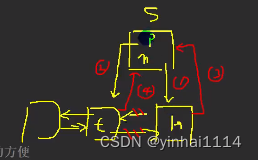

5)模拟一个简单的双向链表
public class LinkedList01 {public static void main(String[] args) {//模拟一个简单的双向链表Node jack = new Node("jack");Node tom = new Node("tom");Node hsp = new Node("老韩");//连接三个结点,形成双向链表(结点也叫对象//jack -> tom -> hspjack.next = tom;tom.next = hsp;//hsp -> tom -> jackhsp.pre = tom;tom.pre = jack;Node first = jack;//让first引用指向jack,就是双向链表的头结点Node last = hsp; //让last引用指向hsp,就是双向链表的尾结点//演示,从头到尾进行遍历System.out.println("===从头到尾进行遍历===");while (true) {if(first == null) {break;}//输出first 信息System.out.println(first);first = first.next;}//演示,从尾到头的遍历System.out.println("====从尾到头的遍历====");while (true) {if(last == null) {break;}//输出last 信息System.out.println(last);last = last.pre;}//演示链表的添加对象/数据,是多么的方便//要求,是在 tom --------- 老韩直接,插入一个对象 smith//1. 先创建一个 Node 结点,name 就是 smithNode smith = new Node("smith");//下面就把 smith 加入到双向链表了smith.next = hsp;smith.pre = tom;hsp.pre = smith;tom.next = smith;//让first 再次指向jackfirst = jack;//让first引用指向jack,就是双向链表的头结点System.out.println("===从头到尾进行遍历===");while (true) {if(first == null) {break;}//输出first 信息System.out.println(first);first = first.next;}last = hsp; //让last 重新指向最后一个结点//演示,从尾到头的遍历System.out.println("====从尾到头的遍历====");while (true) {if(last == null) {break;}//输出last 信息System.out.println(last);last = last.pre;}}
}//定义一个Node 类,Node对象,表示双向链表的一个结点
class Node {public Object item; //真正存放数据public Node next; //指向后一个结点(下一个public Node pre; //指向前一个结点(上一个public Node(Object name) {this.item = name;}public String toString() {return "Node name=" + item;}
}

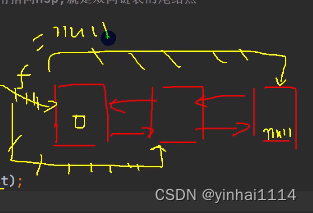
3.LinkedListCURD分析
增加

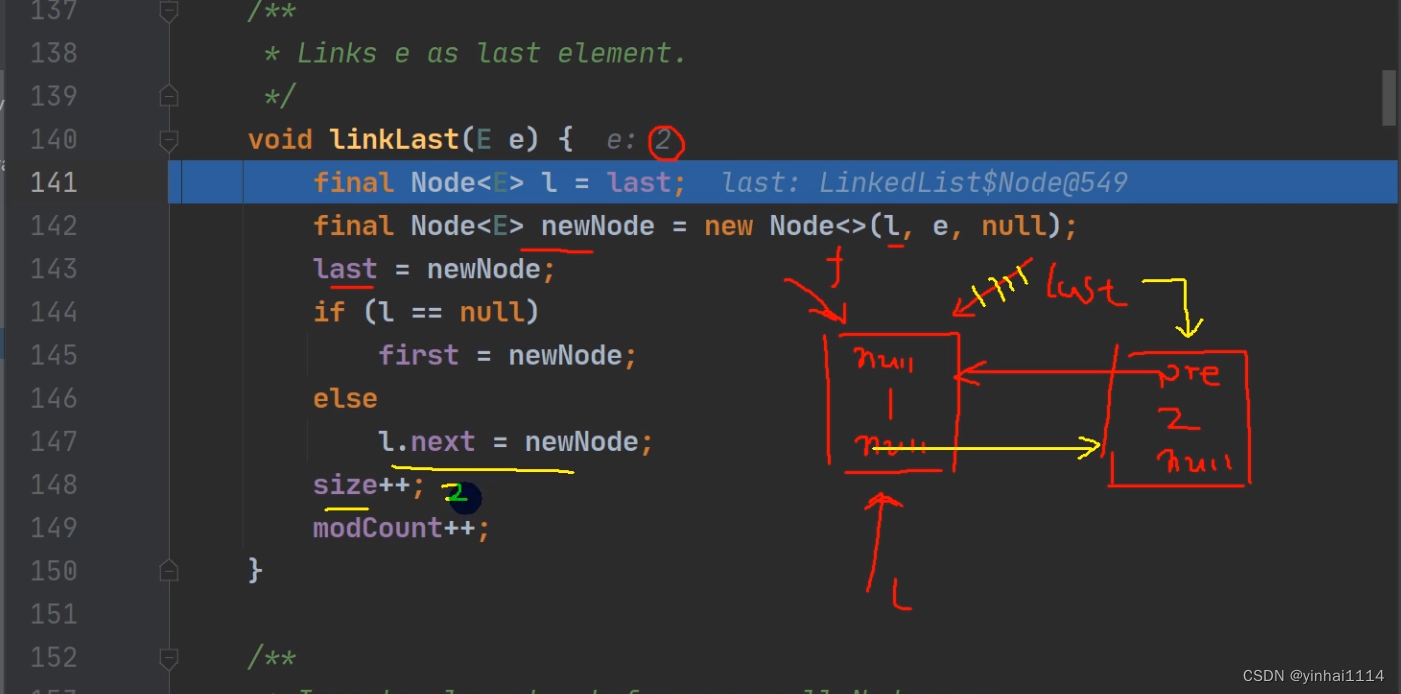
删除

public boolean add(E e) {linkLast(e);return true;}4.将新的结点,加入到双向链表的最后void linkLast(E e) {final Node<E> l = last;final Node<E> newNode = new Node<>(l, e, null);last = newNode;if (l == null)first = newNode;elsel.next = newNode;size++;modCount++;}*///演示一个删除结点的linkedList.remove(); // 这里默认删除的是第一个结点//linkedList.remove(2);System.out.println("linkedList=" + linkedList);/*老韩读源码 linkedList.remove(); // 这里默认删除的是第一个结点1. 执行 removeFirstpublic E remove() {return removeFirst();}2. 执行public E removeFirst() {final Node<E> f = first;if (f == null)throw new NoSuchElementException();return unlinkFirst(f);}/*3. 执行 unlinkFirst, 将 f 指向的双向链表的第一个结点拿掉private E unlinkFirst(Node<E> f) {// assert f == first && f != null;final E element = f.item;final Node<E> next = f.next;f.item = null;f.next = null; // help GCfirst = next;if (next == null)last = null;elsenext.prev = null;size--;modCount++;return element;}*///修改某个结点对象linkedList.set(1, 999);System.out.println("linkedList=" + linkedList);//得到某个结点对象//get(1) 是得到双向链表的第二个对象Object o = linkedList.get(1);System.out.println(o);//999//因为LinkedList 是 实现了List接口, 遍历方式System.out.println("===LinkeList遍历迭代器====");Iterator iterator = linkedList.iterator();while (iterator.hasNext()) {Object next = iterator.next();System.out.println("next=" + next);}System.out.println("===LinkeList遍历增强for====");for (Object o1 : linkedList) {System.out.println("o1=" + o1);}System.out.println("===LinkeList遍历普通for====");for (int i = 0; i < linkedList.size(); i++) {System.out.println(linkedList.get(i));}}
}4.ArrayList和inkedList的比较

如何选择ArrayList和LinkedList:
两个都是线程不安全的
1)如果我们改查的操作多,选择ArrayList
2)如果我们增删的操作多,选择LinkedList
3)一般来说,在程序中,80%-90%都是查询,因此大部分情况下会选择ArrayList
4)在一个项目中,根据业务灵活选择,也可能这样,一个模块使用的是ArrayList,另外一个模块是LinkedList.




)

)


)

![function函数指针和lamada的[]和[=]注意事项](http://pic.xiahunao.cn/function函数指针和lamada的[]和[=]注意事项)








管理)